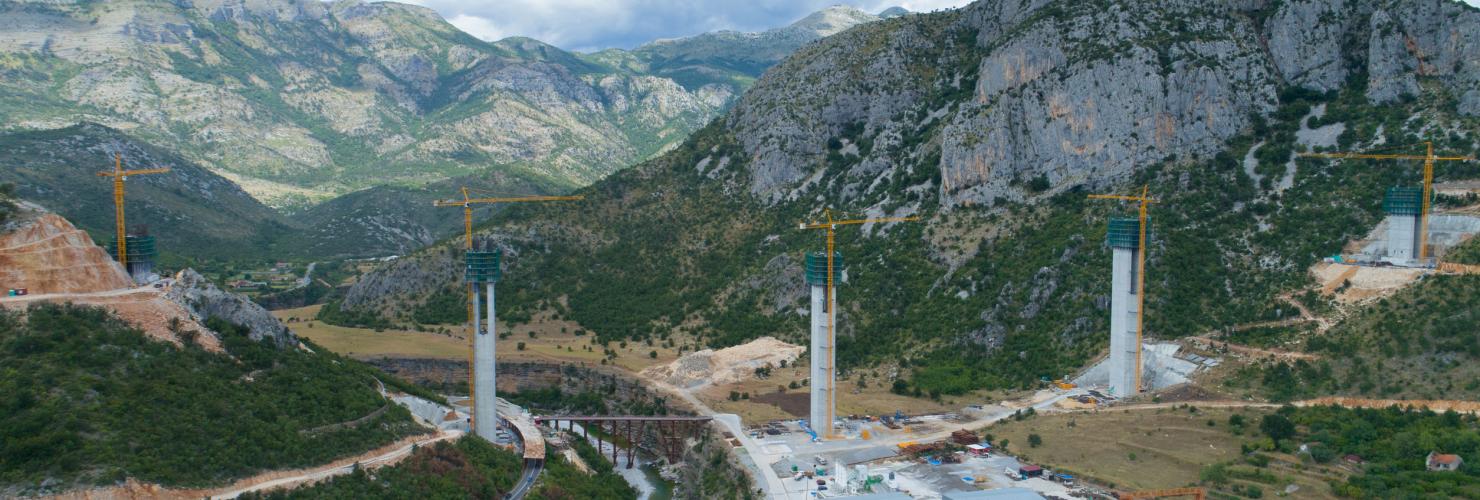

Traveling 60,000 kilometers across China’s Belt and Road
The China Road Project team plans to traverse the Eurasian supercontinent, from London to Jakarta and back again, investigating the infrastructure projects that make up China’s Belt and Road Initiative (BRI). By gathering data on projects and interviewing stakeholders, the project aims to shine a light on what is a much talked about, but little understood initiative. It also seeks to tell the stories of those whose lives are being transformed by the new roads, railroads, ports, and power stations along the BRI.
There has been plenty of ink spilled on the subject of China’s Belt and Road Initiative (BRI) over the past few years. Yet amid this torrent of op-eds there is a dearth of information on the actual ports, railroads, power stations, and other infrastructure that make up the Belt and Road.
Whether you think it's all about “inclusive globalization,” or believe that Beijing’s predatory lending habits are creating “debt traps” for developing countries, many analyses rest on an incredibly small body of data.
BRI projects are difficult to research in offices far from where the action is taking place. In contrast with infrastructure projects funded by multilateral development institutions like the World Bank, they often lack detailed documentation. Whereas hundreds of pages accompany even the smallest World Bank project, thorough research on the relatively well defined China Pakistan Economic Corridor (CPEC) - BRI’s flagship corridor - turns up only a handful of official documents.
By travelling 60,000 kilometers along the Belt and Road, The China Road Project will help to close the knowledge gap created by this lack of information. While on the road, I will share my findings and analyses on the MERICS Blog. I’ll also be providing an on-the-ground angle to MERICS’ Belt and Road Tracker - fact-checking data and following up leads on “zombie projects” that have disappeared from the spotlight of media attention.
Plotting my journey along the Belt and Road
The BRI brand has been liberally applied to almost every field of human endeavor - from bodybuilding competitions to outer space - but the meat and bones of the BRI is hard infrastructure and the soft connectivity that facilitates its use. Power stations, railroads, highways, even fiber optic cables and business parks - these are the tangible aspects of the BRI.
Yet, you won’t find a definitive list of BRI projects, nor official criteria for what is and isn’t the BRI. Instead, delineating BRI projects involves making a judgement call as to which projects best represent the ambitions and characteristics of the Belt and Road as a whole.
The Belt and Road is a foreign policy concept - one that seeks China-led development in order to achieve (ideally mutual) economic prosperity and what Beijing calls a “community of common destiny.” On the ground, the BRI is implemented by Chinese money and Chinese companies. Many big BRI projects are facilitated by loans from Chinese policy banks like the Export-Import Bank of China (EXIM) and carried out by Chinese companies and state-owned enterprises.
The China Road Project roughly follows the logic behind the MERICS’ Belt and Road Tracker - defining the Belt and Road with reference to the policy goals and rhetoric associated with the initiative. Armed with this list of projects, most of which involve Chinese state financing and companies, I will chart a route that takes me out of Western Europe, down the Adriatic Coast into the Balkans and Greece, across Turkey and the Caspian Sea into Central Asia, China, and eventually Southeast Asia.
In rhetoric, the BRI extends as far as Latin America, but it is fundamentally a Eurasian vision. The glory of the ancient pan-Eurasian Silk Road is fundamental to the BRI narrative This is made most explicit in writings by Chinese academics on the BRI. Ming Hao, for instance, describes the BRI as facilitating the rejuvenation of ancient continental civilizations in relation to the modern maritime powers of Europe and the United States.
Connectivity is the central pillar of the BRI story - specifically connectivity with China. I seek to test the connective sinews that constitute the BRI by approaching Beijing from the West, along the overland “belt” portion of the initiative, before returning to Europe by cargo ship, along the maritime “road” portion through Southeast Asia and across the Indian Ocean.
Europe
Europe’s role in the Belt and Road is complicated. Developed European economies are not as desperate for infrastructure as some of the developing countries that the BRI aims to transform. Stringent EU rules governing infrastructure finance and implementation, such as procurement practices, preclude Beijing from going about business as it does elsewhere in the world. There is also the reality of geopolitical competition (or at least strategic wariness) between the EU and China that further complicates the relationship, and many European leaders have voiced apprehension regarding the Sino-centric nature of Beijing’s Belt and Road plans.
On the other hand, Western Europe is the terminus of the much-hyped trains traversing the rejuvenated “New Silk Road.” For China, it is a fantastic potential market, and it boasts an ecosystem rich with potential acquisition targets for Chinese companies - already it receives a sizable bulk of Chinese overseas investment.
In Europe’s southeast, countries are more open to the idea of greenfield investment in infrastructure from China. Montenegro, for example, which belongs to China’s controversial 16+1 grouping of Central Eastern European countries, is already receiving more financial help for infrastructure projects from Beijing than from the EU. (It is worth noting however, that infrastructure financing from Brussels still dwarfs funds from Beijing in all EU member states.)
Central Asia
My journey will proceed through the Balkans and Greece, entering Asia at the historical juncture between the two continents: Istanbul. I will drive the length of Turkey, investigating Chinese investments and hoping to discover more about the dynamic relationship between these two curiously aligned powers. From the Caucasus I will take the trans-Caspian route into Kazakhstan to begin the Central Asian leg of my journey.
In absolute terms, BRI investment in this sparsely populated ocean of land is not terribly significant. Central Asia is, however, key to the idea behind the BRI - of leading the left-behind into a new stage of development spurred by connectivity with China. It’s also the heart of the ancient Silk Road, a mixing palette of Russian and Chinese influence, and it was here, in Kazakhstan, where Xi Jinping first unveiled the overland portion of his Belt and Road plans.
I will snake across Central Asia visiting each country in the region barring Turkmenistan, whose arduous visa regime makes it prohibitively expensive to traverse. In Almaty, I will reluctantly drop off my vehicle since strict regulations in China make it nearly impossible to complete my trip to Beijing by car. Instead, I will take a combination of buses, trains, and hired drivers to continue my pilgrimage. My journey across the historic silk route will continue through the ancient capital of Xi’an to China’s present-day capital and Belt and Road headquarters, Beijing, and finally on to the vaunted Chinese tech mecca of Shenzhen.
South and Southeast Asia
My journey in Southeast Asia is organized around the official China-Indochina Peninsula and Bangladesh-China-India-Myanmar Economic Corridors. From Myanmar to Singapore, economic and political contexts vary, and each country in the region has its own complex relationship with China. That’s why this leg of my journey promises to be the longest and most diverse.
This is also the area of the world in which I expect to see the largest Chinese presence, particularly when it comes to e-commerce agreements and the futuristic sounding “Digital Silk Road.”
The final leg of my journey will be spent on cargo ships. I will return to Europe via the Maritime Silk Road across some of the world’s busiest shipping lanes, and I aim to make port calls along the way. Sri Lanka, Pakistan, Djibouti, and Ethiopia are on the agenda.
Of course, with a trip like this, flexibility is a must. Political restrictions in places like Myanmar change rapidly, and new projects are constantly being launched, some of which might end up more attractive than projects on the original to-do list. Throughout the journey, I expect to encounter a significant number of externalities beyond my control as well as new leads that shouldn’t be ignored. Ultimately, I believe that equipping myself with as much knowledge as possible, a good provisory plan, and an openness to change is the best way to plot the trip.
Whichever way the road map is ultimately drawn, the most important item to bear in mind will be my project aims. As stated on the “mission” page of my website, my objectives are two-fold. First, I want to shine a light on an under researched foreign policy concept, one which I believe might define the 21st century in much the same way that the United States’ blueprint for the post-WWII order defined the 20th. By providing original data on projects, I hope to can help journalists, researchers, and decision-makers better understand this defining movement.
I also want to bring the Belt and Road into focus, by tracking not only the physical processes of development, but by exploring the human dimensions of these changes - by telling the story of those individuals whose lives are being transformed by the roads, railroads, and power stations crisscrossing our Eurasian supercontinent.
This blogpost is an adaptation of a previous article, published October 11, 2018 on the website of Reconnecting Asia, a project by CSIS. Jacob Mardell, Freelance Researcher at MERICS, will start his trip along the "Belt and Road" in March.
